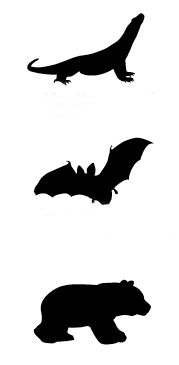
The Great Veggie Burglar
Two marvels in one: a spider that loves vegetables and a master thief, adept at nabbing golden treasures from fiercely guarded repositories.
Hiding in the shadows, the thief waits for the patrol to pass. Then, seizing the moment, he rushes in, takes the treasure, and makes his getaway before the guard returns.
This crafty burglar is Bagheera kiplingi, an athletic arachnid of peculiar tastes. Prior to scientists’ discovering its unusual eating habits, nobody imagined that any spider would find plant parts palatable. Then researchers discovered this spider is a vegetarian! Not only that, it must display singular cunning and agility to acquire its favorite food.
To nab its prize, the spider must get past the stinging Pseudomyrmex ants. Few proprietors take home ownership so seriously. They guard their home, the bullhorn acacia tree of South and Central America, with fierce determination. The ant colony constantly sends out sorties to patrol the entire tree for unwelcome visitors, whether plant or animal. They have a zero-tolerance policy for anyone who dares to snack on their leafy abode and will carry out swift punishment on the trespasser.
The ants make their home in the tree’s hollow thorns, and they live off the tips of the leaflets, called Beltian bodies. These are tiny oval packages of nutrients, produced only when an ant colony is living on the tree. At the base of the leaves are also nectar-filled dishes to feed patrolling ants while on duty.
This is a textbook example of mutualism. The tree provides food, drink, and shelter for the ants; and the ants provide protection for the tree.
But B. kiplingi wants those Beltian bodies. And it has the smarts and agility to breach the ants’ defenses.
Jumping spiders don’t build webs to catch prey. Instead, they hunt, and B. kiplingi is a master hunter. It uses its well-honed hunting skills to avoid ant patrols and stalk its favorite veggies or forbidden nectar. Like all other jumping spiders, B. kiplingi has excellent vision. It skillfully skulks about the skinny branches, keeping all four pairs of eyes on the patrolling ants. If it gets cornered, it jumps away with its powerful legs or drops out of reach on a silk strand.
This spider goes on occasional predatory sprees, but animal food accounts for only a small portion of its diet.
Unusual as a vegetarian spider may seem, it shouldn’t shock us. Before the Fall all animals were vegetarian (Genesis 1:29).
Unusual as a vegetarian spider may seem, it shouldn’t shock us. Before the Fall all animals were vegetarian (Genesis 1:29). B. kiplingi is another reminder that critters with predatory parts could have devoured veggies instead. This little eight-legged burglar has learned how to make its home in a “no trespassing” tree crawling with six-legged storm troopers.
Something New, Something Old
The modern world is full of species that live in very specific habitats and subsist on highly specialized diets. B. kiplingi lives only in the Western Hemisphere and feeds on a species of acacia found only there. So how did bullhorn-acacia-loving ants and Bagheera spiders survive after the Flood, before their specialized food source could grow?
There’s no reason to believe these species existed before the Flood. Instead, their ancestors were genetically equipped to diversify into a variety of species that could fill different habitats after the Flood.
Most likely, these ancestors were very flexible in what they could eat and where they could live. They only became specialized over time, as plants and animals settled into their current niches.
Today if we plop specialized descendants down in a foreign place, they’re likely to die. But the hardy Flood survivors would have been extremely versatile in both looks and tastes.
As decades rolled into centuries and habitats became more defined, so did their inhabitants. Each was molded into a highly specialized way of life. And they can’t go backwards, any more than a poodle can become a wolf.
Of course, the ability of an acacia tree to produce Beltian bodies and nectar dishes didn’t evolve from scratch. Nor did the skills of a jumping spider to pursue food. Only with time did the adaptability God designed into the original created kind result in a particular species with the ability to outwit ant patrols and burgle Beltian bodies.
While some of these behaviors remind us how sin has marred God’s creation, they still point to the handiwork of the all-wise Creator, who designed life to reflect his glory and made sure it would manifest his wonders even after Adam sinned.
Meat or Veggies?

Spiders aren’t the only so-called meat-eaters that can feed on plant material, as they must have done before Adam’s Fall.
Monitor Lizard
While most monitor lizards eat only meat, some types like Gray’s monitor eat primarily plants, and the adults do just fine without any meat at all.
Fruit Bat
The fruit bat has ferocious, needle-sharp teeth, which it uses to cut through the tough outer skin of fruit. It then crushes the fruit, swallows the juice, and spits out the pulp.
Giant Panda
Even though it’s a bear and has a bear’s sharp teeth, the giant panda eats almost exclusively bamboo.
Answers Magazine
September–October 2017
The Creator equipped numerous animals with astonishing tools to find their way as they migrate around the world.
Browse Issue SubscribeRecommended Resources

Answers in Genesis is an apologetics ministry, dedicated to helping Christians defend their faith and proclaim the good news of Jesus Christ.
- Customer Service 800.778.3390
- © 2024 Answers in Genesis





